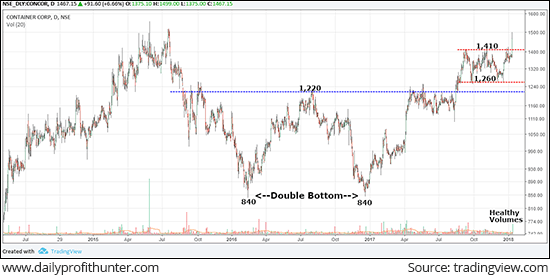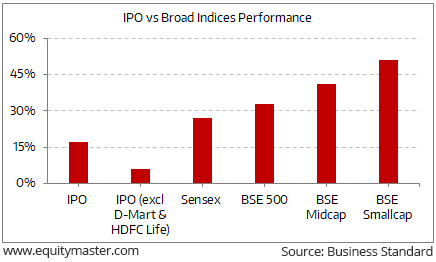After opening the day flat, share markets in India witnessed volatile trading activity throughout the day and ended the day on a dull note. Losses were seen across most sectors with stocks in the auto sector and stocks in the consumer durables sector, leading the losses. While stocks in the IT sector gained the most.
At the closing bell, the BSE Sensex stood lower by 10 points (down 0.1%) and the NSE Nifty closed down by 5 points (down 0.1%). The BSE Mid Cap index ended the day down by 0.4%, while the BSE Small Cap index ended the day flat.
Asian stock markets finished mixed. As of the most recent closing prices, the Hang Seng was up by 0.2% and the Shanghai Composite was up by 0.2%. The Nikkei 225 was down by 0.3%. European markets were trading on a negative note. The FTSE 100 was down by 0.1%. The DAX too, was down by 0.6% while the CAC 40 was down by 0.2%.
The rupee was trading at Rs 63.63 against the US$ in the afternoon session. Oil prices were trading at US$ 63.4 at the time of writing.
In news from global financial markets. The Bank of Japan (BOJ) trimmed the amount of its government bond purchases, triggering speculation that the Japanese central bank may wind back its monetary stimulus this year.
BOJ Governor Haruhiko Kuroda has repeatedly dismissed the chance of withdrawing stimulus any time soon, even as some policymakers have recently expressed concerns over the perceived demerits of monetary easing, especially the hit on financial institutions' profit margins.
That has led to speculation that the central bank may have to consider raising its yield targets or slow purchases of risky assets later in 2018 and bringing Japan in line with a host of developed nations which have started to tighten policy, partly thanks to a synchronized uptick in global growth.
Minutes of the Japan central bank's last policy meeting released late in December showed that a majority of policymakers agreed that central bank must persistently purse powerful monetary easing. But additional stimulus measures were unnecessary for now.
The BOJ kept its policy steady as preferred by most of its policymakers at the two-day meeting that ended on 31 October 2017.
A majority of the members were of view that extreme monetary easing only to achieve price goal could prevent monetary accommodation from producing intended policy effects. So taking additional monetary easing now would have more demerits than merits.
The minutes also noted that the effects and costs of buying risky assets like exchange traded funds (ETFs) must be looked from every angle even if the move had yet to distort market functions at this point.
The BOJ is lagging behind the US Fed and ECB in exiting the ultra-easy policy. But sooner or later, Japan will have to withdraw the easy money policy.
Moving on to news from the IPO space. Apollo Micro Systems' IPO which launched today was already oversubscribed by 1.35 times on the first day. The offer will be open till 12th January and the company intends to raise Rs 1.5 billion from its public offering.
Over last two decades, Apollo Micro Systems has developed an established brand name, acceptance and recall value in the defence ESDM sector. It is an electronic, electro-mechanical, engineering designs, manufacturing and supplies company and designs, develops and sells high-performance, mission and time critical solutions to Defence, Space and Home Land Security for Ministry of Defence, government controlled public sector undertakings and private sectors.
The price band of the IPO is finalised at Rs 270 to Rs 275 per share.
Should you subscribe to its IPO? We have analyzed this IPO and have released our analysis on the company. You can access it here (subscription required).
IPOs Underperform Broad Market Indices
2017 will undoubtedly be considered as the year of IPOs. The IPO activity is headed for a record. They have garnered more than Rs 650 billion, surpassing the previous record of Rs 375 billion in 2010. This year, the demand has exceeded expectations.
What if one had invested in all the IPOs? How have the IPOs performed in 2017? And, have they outperformed the indices?
According to an article in Business Standard, an investor who bet on the 33 IPOs of 2017 (on a weighted average basis) has seen the value of investment rise by 17%. However, compared to broad market indices, the underperformance is a bitter disappointment.
The above chart clearly shows the underperformance of IPOs.
Interestingly, if you take the Avenue Supermarts (D-mart) and HDFC Life out of the equation from the IPOs above, the gains drop to a meager 6%. Compared to this, the Sensex has gained 27%, while the small-cap index surged more than 50%.
What is the reason for this underperformance?
One of the key reasons IPOs have touched the altitude is due to a surge in the Indian equity market backed by liquidity and increasing investor demand for financial assets. Private equity investors and promoters took advantage of the absurd demand and came out with sky-rocket valuations. This is what we call a valuation bubble in the IPO market.
During such times, it is imperative to be critically selective when investing in IPOs. Carefully analyse each company for its own merits and don't give in to the hype surrounding the public offering.
That's Ankit Shah's approach at Equitymaster Insider. He keeps an eagle-eye on the developments in the IPO space and updates his readers on the big-ticket IPOs.
Ankit and his team of researchers constantly reference this handbook on investing in IPOs. You can download a copy for yourself. It is free. Just click here.
And here's a note from Profit Hunter:
The Container Corporation of India (CONCOR) is among the most active stocks in the market today - up 7%. Let's have a look at its chart.
The stock bottomed out at 840 level in February 2016. It bounced up to 1,220 in August 2016, but slipped again to 840 level; where it had found support from February 2016 low.
It rebounded strongly from the 840 level to form a double bottom pattern. The stock broke out of this pattern in August 2017 to peak at 1,413, its 52-week high.
It then traded between the range of 1,260 - 1,410 for about four months. Today, the stock broke out of this range, on the upside with healthy volumes, to touch a new 52-week high of 1,499.
Stocks usually tend to outperform after they achieve a new 52-week high. To know more read here (subscription required). Now the stock is only a few percentage away from its life-time high of 1,558.
Can we soon see a new life-time high in the stock? Let's see how the price action turns out in the sessions to come.
CONCOR at a New 52-week High

This article was originally published in English at www.equitymaster.com
Read the complete Indian stock market update. For the terms of use, go here.

No comments:
Post a Comment